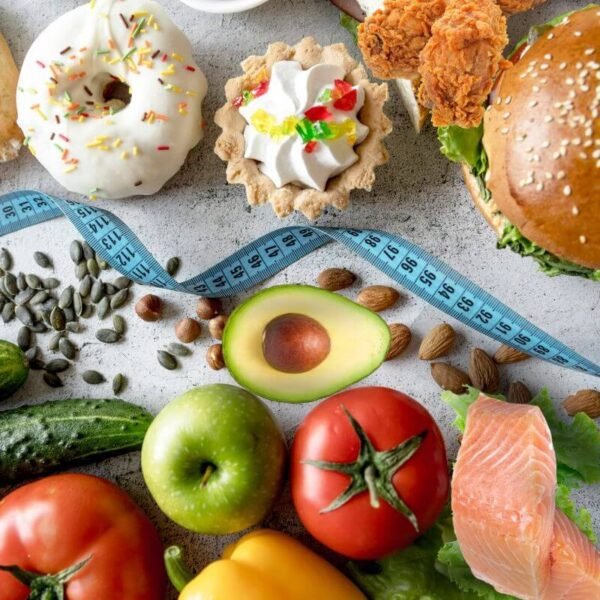While the ketogenic diet’s primary focus was initially medical, it has gained significant mainstream popularity over the years as a weight-loss regimen and lifestyle choice for improved metabolic health. The whole idea of the diet is igniting a remarkable metabolic process called Ketosis, so people usually ask how long to get into Ketosis.
The process does not start instantaneously; instead, it requires time and adherence to rigorous requirements. But finally, some researchers have discovered the most expeditious approach to achieving Ketosis.
And we’ll look at it here, however, before delving into that, let us examine and comprehend the process itself.
What is Ketosis?
Ketosis is a natural process that occurs when your body uses fat as its energy source instead of the blood sugar (glucose) which is the body’s main fuel source.
Typically, glucose is obtained in your diet by consuming carbohydrates (carbs) like starches and sugars. The body breaks down these carbs into glucose, which is energy. Any excess glucose is stored and saved in the liver and would be released when the body needs it.
When you take very few carbs, there is not enough glucose available to provide enough energy, and these glucose stores run out.
The body will adopt an alternative strategy to meet those needs; it starts burning fat instead for energy. Ketones are a type of chemical that your body makes when it breaks down fat. The ketones, also called ketone bodies, become the main energy source for your body and brain.
The liver makes a small amount of ketones on its own. Still, your insulin level goes down when your glucose level goes down, which pushes the liver to produce more ketones to respond to the needs of the body and the brain; during this process, the blood contains a high level of ketones.
What is the ketosis diet?

The ketogenic (keto) diet changes how your body uses food. Most of the power your body needs comes from the carbohydrates you eat. The keto diet cuts down on the number of carbs you consume and pushes your body to burn fat instead.
The keto diet consists of a lot of fat, few carbs, and not much protein. A typical keto diet has 70% to 80% fat, 5% to 10% carbs, and 10% to 20% protein.
Plenty of nourishing foods are abundant in carbohydrates, including whole grains, fruits, and vegetables. However, on the keto diet, carbohydrate intake from all sources is restricted. Consequently, a complete elimination of bread, cereal, and other grain-based products and significant reductions in fruit and vegetable consumption are necessary. Notably, the keto diet relies on specific food groups to supply the required fat content, such as:
Meat and fish.
Nuts and seeds.
Butter and cream.
Eggs. and Cheese.
Oils such as olive oil and canola oil.
How many carbs do I need for Ketosis?
Since Ketosis involves the breakdown of fat reserves within the body, specific keto diets expedite weight loss by inducing this metabolic condition.
Keto diets are usually high in fat. For example, 20% of the calories may be protein, 10% may be carbs, and 70% may come from fat., In another way, You’ll need to stay under 50 grams of carbohydrates per day to enter and stay in Ketosis.
How Long Does It Take to Enter Ketosis?
Eating between 20 and 50 grams of carbs daily will generally take you two to four days to get into Ketosis. But the time it takes to reach this state depends on a number of things. That might delay the process for a week or more.
If you eat a high-carb diet before starting a keto diet, it may take you longer than someone who eats a low-carb diet to get into Ketosis. Your body needs to use up all of its energy stores first.
With intermittent fasting, you can get into Ketosis faster. The most popular way to do intermittent fasting is to eat everything you need to eat in eight hours.

Why does it take longer to enter Ketosis for some people?
As previously discussed, numerous factors can determine how quickly your body enters Ketosis; it could take days or weeks depending on various circumstances and influences such as:
Carbohydrate Intake: Carbs are the key factor determining when Ketosis will occur. Ketosis typically starts when all glycogen stores in your body have been depleted – usually taking only 2-4 days with low carb consumption; some individuals may take longer if they consume more carbohydrates regularly.
Metabolic Rate: Individuals with faster metabolisms may move more quickly into Ketosis as their bodies utilize fat as fuel more rapidly and reduce glycogen stores faster.
Activity Level: Exercise can help deplete glycogen stores more rapidly and hasten the transition into Ketosis. People who only move around a little may take longer to reach this state.
Dietary Fat Intake: Consuming sufficient nutritional fat is crucial to reaching Ketosis. Some individuals may consume insufficient fat or restrict it too severely, which could delay getting Ketosis.
Hydration: Hydration is key for supporting metabolic processes, including Ketosis. Dehydration could delay its onset.
Insulin Sensitivity: Individuals suffering from insulin resistance or metabolic conditions may take longer to enter Ketosis as their bodies have difficulty processing glucose efficiently.
Stress and Sleep: High stress levels and insufficient rest may wreak havoc with hormones like cortisol and insulin production, hindering Ketosis.
Protein Consumption: Too much protein consumption may also work against Ketosis as excess proteins can be converted to glucose through gluconeogenesis or turning extra proteins into sugar in your system.
It’s essential to remember that the rate at which someone enters Ketosis does not necessarily indicate its effectiveness; what matters more is adhering to a well-balanced ketogenic diet for health and weight loss goals over time.
What are the benefits of Ketosis?
Research indicates that Ketosis may offer various health advantages. One such benefit may be weight loss: Ketosis can make you feel less hungry and lead to less food, helping reduce visceral fat (belly fat). Ketosis may also aid in treating and managing diseases such as cancer.
Epilepsy:
Healthcare providers often turn to the keto diet to decrease or prevent seizures by changing their brain’s “excitability” portion.
Type 2 Diabetes:
Research shows the keto diet can assist those living with Type 2 diabetes to lose weight while managing their blood sugar levels more effectively.
Heart Disease:
The keto diet can lower your risk of cardiovascular disease by reducing your blood pressure, raising HDL (“good”) cholesterol levels, and decreasing triglycerides.
Metabolic Syndrome:
Following a keto diet may lower your risk of metabolic syndrome, which increases heart disease risk.
Other conditions:
Research indicates the keto diet may help ease neurological disorders like Alzheimer’s, autism, and even brain cancers such as glioblastoma.
Ketosis helps increase your focus and energy. The keto diet provides energy needs in an anti-inflammatory fashion; studies indicate that your brain works more efficiently on ketones rather than glucose.
What are the side effects of Ketosis?
Although Ketosis may provide numerous positive outcomes when it comes to weight loss and overall health, there may be some side effects as well – here is a list of them :
Keto Flu: symptoms that some may experience while transitioning into Ketosis can include fatigue, headache, nausea, dizziness, irritability, and difficulty sleeping. These effects are generally temporary and manageable with adequate hydration and electrolyte intake.
Digestive Issues: People starting a ketogenic diet experience digestive discomfort, such as constipation or diarrhea, upon switching their fiber intake. However, this should soon settle once their bodies adjust.
Dehydration: Ketosis may lead to increased urination, leading to dehydration if your fluid intake does not match up with your output. To counter this risk, make sure you intake enough liquid.
Bad Breath: People going into Ketosis may notice a metallic or fruity odor on their breath during this state, known as “keto breath.” This odor is caused by the acetone ketone molecules produced during Ketosis.
At first, those engaging in high-intensity workouts may experience a reduction in performance; this usually improves with time as their bodies adapt to using fat as fuel instead.
Mineral Imbalances: Ketosis can disrupt the balance of minerals in the body, such as sodium, potassium, and magnesium levels. Maintaining adequate electrolyte levels is vitally important.
Cholesterol and Lipid Changes: While some individuals experience improved lipid profiles, others may see an increase in LDL cholesterol. Therefore, individuals must monitor any changes that might arise and monitor them closely.
Hormonal Changes: Women who follow a ketogenic diet may experience menstrual irregularities as their hormone levels change, contributing to menstrual irregularity.
Not all individuals experience these side effects of Ketosis; for some, the benefits, such as weight loss and improved energy levels, outweigh any initial discomfort experienced when entering this state.

Safety is the key.
Ketosis is a natural metabolic state that can occur if an individual adopts a low-carb or low-calorie diet.
Reaching Ketosis may be desirable for various reasons, including weight loss, fat reduction, managing type 2 diabetes, and improving heart health.
However, Ketosis isn’t suitable for everyone. Prolonged ketosis may have negative repercussions in some individuals; those living with type 1 diabetes should avoid entering Ketosis since protracted exposure increases the risk of ketoacidosis, a potentially life-threatening condition. Therefore, many nutritionists advise that Ketosis should be maintained for short periods.
Additionally, doctors do not advise the ketogenic diet for people taking insulin or suffering from liver failure, pancreatitis, or having been previously diagnosed with high cholesterol.
Any questions about the keto diet should be addressed directly to a healthcare provider first.












